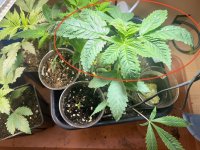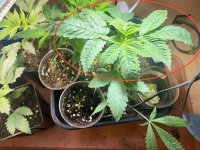Hi Breeders!
In my nursery i have this young plant with big wrinkly and curved leaves, while all other plants are in a fairly good shape. My temps in there are 20°min 24° max with humidity around 70%. I've tried both raising and lowering the temps and humidity, still the same. My feeding solutions ph is 5,8-6, i can't measure the soil ph at the momenty, but i'm sure it's good. At this point i'm thinking it must be genetics or some bacteria or virus infected it (?). Any of you guys has some opinion to share? Thaks
In my nursery i have this young plant with big wrinkly and curved leaves, while all other plants are in a fairly good shape. My temps in there are 20°min 24° max with humidity around 70%. I've tried both raising and lowering the temps and humidity, still the same. My feeding solutions ph is 5,8-6, i can't measure the soil ph at the momenty, but i'm sure it's good. At this point i'm thinking it must be genetics or some bacteria or virus infected it (?). Any of you guys has some opinion to share? Thaks




